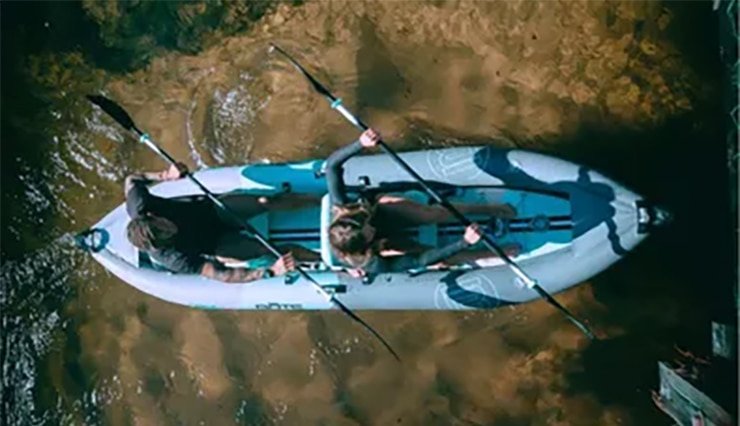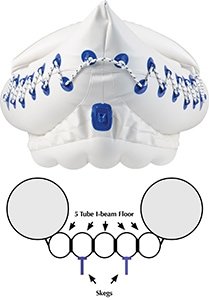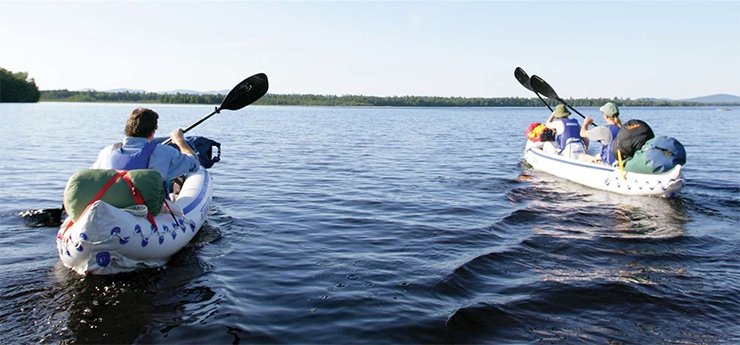Inflatable kayaks, by their very nature, do not sound like something built with durability in mind. The last thing you want when out on the water is to get a puncture in your boat – so it’s surely better to opt for a hardshell, right?
Well, you might be surprised to find out that the latest top rated inflatable kayaks offer just as great, if not better, features than your traditional hardshell.
Not only are the latest inflatable kayaks more durable than the early era inflatables, they also offer benefits that hard shell kayaks simply can’t match. Inflatable kayaks are easier to tote around, offer fantastic performance, and come in various styles to accommodate your kayaking needs.
Benefits like these just scratch the surface in terms of why modern inflatable kayaks have been gaining traction over the past decade. Today, we’re going to explore just how durable an inflatable kayak is, and what you might be missing out on.
Stick around to see how inflatable kayaks have simply dominated the kayaking landscape over the past couple of years.
Also read: Inflatable boats and inflatable kayaks – which to choose?
Key Takeaways
- Inflatable kayaks are durable, safe, and easier to transport compared to hardshell kayaks.
- They are made of high-quality materials like PVC, Hypalon, and Nitrylon, and have multiple air chambers to prevent punctures.
- Manufacturers also use drop stitch technology to create a rigid and stable floor that can be inflated to a high PSI.
- Inflatable kayaks come in various styles and designs to suit different types of kayaking activities like recreational, touring, whitewater, and fishing.
- Inflatable kayaks can last for five to ten years with proper care and maintenance and can be repaired with a simple patch kit.
Hardshell vs. Inflatables: Know the Difference
If you’re still wondering ‘are inflatable kayaks durable’ then it’s important to compare them with hardshells to see how they stack up. The main difference is that inflatable kayaks are inflatable, while hard shells are made from hard materials like plastic. As a result, hard shells are often heavier than inflatable kayaks.
Hardshell kayaks will always require some sort of towing or roof rack system in order to tote them around. Then, when you get to your destination, you’ll likely deal with a heavy boat that can be cumbersome to carry.
Also read: How to transport a kayak.
Inflatable kayaks can take all that stress away. Many inflatable boats come with some sort of efficient pack and carry system. Comfortable carry handles and backpack configurations allow you to launch your kayak in even the most remote places.
How Durable are Inflatable Kayaks?

It used to be that inflatable kayaks were typically made out of a cheaper PVC material. Innovation in both construction and design has largely changed this over the past couple of years.
The main game changer in an inflatable kayak’s durability has been drop stitch construction. Traditional inflation requires air to be pumped into a chamber which is typically made out of vinyl or PVC material. Traditional inflatables will usually require a PSI ranging from 2 – 4.
Related: Are inflatable kayaks any good?
With drop stitch technology, thousands of tiny fibers connect the top chamber to the bottom. Drop stitch construction also allows you to inflate anywhere from 6 PSI all the way to an impressive 10 PSI as seen with the Sea Eagle RazorLite. This higher PSI is what gives drop stitch kayaks a rigid feel, mimicking a hardshell kayak.
Read the full review of the Sea Eagle Razorlite
Materials Used in Making Inflatable Kayaks
There are a variety of different materials that can go into an inflatable kayak. Typically, however, most inflatable kayaks are made out of a durable PVC and Hypalon material that is over a stretched polyester fabric.
These synthetic materials are especially durable, keeping your inflatable lasting longer. More recently, Nitrylon, a lamination of synthetic and natural rubber, has been introduced in making durable kayaks.
Some kayaks might go a step further in adding a protective layer like a polyester coating over spray skirts or tarpaulin bottoms underneath the hull. Layers like this can further help prevent your inflatable kayak from getting punctured when coming across rough or compromising objects.

What is an I-Beam Floor
An I-beam floor gets its name from the long “beams” that run along the vertical length of your boat’s flooring. An I-beam floor is supposed to give your boat a little more rigidity on the base.
You’ll see this type of construction on a variety of inflatable kayaks, including recreational ones. A major downside of I-beam floors is that they can be difficult to stand on, and will require some getting used to if you want to row standing, like on a SUP.
Upgrade with Drop Stitch Technology
Drop stitch technology is the latest trend with inflatable kayaks and it’s easy to see why. Because you can inflate drop stitch to a higher PSI, you will have a much better time standing on an inflatable kayak that has this feature.
High quality inflatable kayaks have drop stitched constructions, especially those that transform into stand up paddle boards (SUP). Other high quality great entry level boats may use drop stitch technology only on the floor, in an effort to get first time kayakers comfortable. The rigid construction also helps with easier paddling in SUP mode.
Multiple Air Chambers Provide Increased Safety
Along with the high quality material that is used in inflatable kayaks, multiple air chambers allow inflatable kayaks to be especially durable.
High quality inflatable kayaks will usually have at least three chambers. The floor, and one chamber on each side. If you do happen to get a puncture in one chamber, you will still stay afloat because of the other chambers.
Inflatable kayaks that feature multiple chambers are much safer than even some hard shells because you will always be able to get safely back to shore to repair the puncture.
How Long do Inflatable Kayaks Last?

A high quality inflatable kayak can last you anywhere from five to ten years. Of course, it all depends on how well you take care of your inflatable.
A rinse your inflatable kayak off before you pack it away. They are made out of special coatings that if kept unclean can break apart and weaken over time. Use a drying towel on the inside and outside of your kayak. You can use a mild soapy solution to clean up stubborn gunk.
As a general rule, avoid harsh cleaners containing ammonia, chloride, or bleach.
Also read: What size kayak do I need?
Do Inflatable Kayaks Pop Easily?
Inflatable kayaks don’t pop easily. But that isn’t to say that they don’t pop ever.
Whether or not your inflatable kayak will pop depends on your kayak and the type of protective layers it has. How you use your kayak will also determine whether or not your kayak has a chance of getting popped.
Inflatable kayaks that are meant to be used for recreational and touring purposes have a low chance of popping. Especially if you use them in waterways that are rather deep and are clear of underwater plant growth like Lilly pads or mangroves.
Other inflatable kayaks used for intense recreation like whitewater kayaking can have a higher chance of popping, especially if there are lots of jagged rocks. However, many high quality inflatable whitewater kayaks are specially designed with protective bottoms to keep this from happening.
If you’re worried about your inflatable kayak popping, don’t be. While you certainly may be able to pop your kayak, the chances are relatively slim.
How to Repair a Punctured Kayak

Whether it’s a drop stitched kayak, an I-beam floor, or a traditional kayak, every inflatable kayak will come with a repair kit. The kit will typically include a small swatch of the durable materials used to make your kayak.
Repairing your inflatable kayak is rather simple and straightforward. You simply deflate the boat, find the puncture, clean it well, and apply the glue and patch.
You should always let a repair dry for at least 12 hours before inflation. Some inflatable kayaks may come with instructions specific to your model.
Also read: Do inflatable kayaks need to be registered?
Is an Inflatable Kayak Right for You?
So, is an inflatable kayak right for you? With so many options available to outdoor enthusiasts, you will certainly be able to find the best inflatable kayak to meet your needs. Let’s take a quick look at some of the top pros and cons you can expect with an inflatable kayak.
- You don’t need a roof rack or tow truck to transport your inflatable kayak. Plus they’re easy to pack up and carry around.
- Inflatables feature accessories including fishing attachments, a tracking fin, self bailing holes, and carbon fiber oars for better paddling.
- Separate inflation chambers make inflatables especially safe while on the water.
- Paddling is comfortable thanks to ergonomic adjustable seats found in many inflatables.
- Much like a hard shell, a range of inflatable boats on the market are geared for specific activities including light touring, fishing, or white water rafting.
- Inflatables might not track as well as a hard shell, but the best inflatable kayaks include tracking fins to help fix tracking issues.
You may also like: Are inflatable kayaks good for fishing?
Conclusion
With the evolution of inflatable kayaks, it’s no wonder the world of inflatable kayaking is only growing. Soon, inflatable kayaks will be the boat of choice for those looking to go out on a paddling adventure.
As cheaper materials are being swapped out for higher quality materials in the construction of inflatable kayaks, inflatables can quickly outrank hardshell kayaks. Especially when it comes to the topic of durability, safety, and performance. With that said, yes, inflatable kayaks are just as durable, if not more so, than hardshell kayaks.
Be sure to share with us your thoughts on inflatables and hard shell kayaks. Which model do you prefer and why? Let us know in the comments section below!

